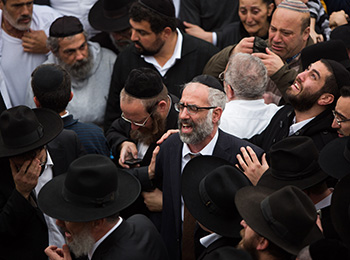TORONTO — The tragic deaths of seven siblings in a house fire in Brooklyn, N.Y., earlier this month underscores the need for observant Jews to respect the dangers posed by fire, says the rabbi of an Orthodox Toronto synagogue.
Rabbi Yehoshua Weber of Clanton Park Synagogue, said Jews deal with open flames and long-running electrical appliances more than the general population, “so we have to be especially vigilant. We should have smoke alarms that are monitored, and be especially vigilant about it. I see it as a halachic imperative.”
Rabbi Weber was commenting a few days after a March 21 house fire in Brooklyn claimed the lives of seven brothers and sisters. Preliminary investigations suggested a faulty hot plate, used to keep food warm during the Sabbath, was to blame.
More than a year ago, in a synagogue bulletin, Rabbi Weber warned his congregation about the dangers of not adequately respecting fire.
In his case, the carbon monoxide detector in his home went off on a Shabbat morning, the third day of a three-day yom tov (holiday).
The house was cleared and no one was hurt. Fire department officials said the alarm went off because of inadequate ventilation.
“The constant burning of the gas range and oven – even on a low flame, will over time emit unhealthy levels of carbon monoxide. I was told that the fire department was tending to many such calls over the last few days. The firemen implored me to please tell the rabbis and announce to the community that if people need to leave on the stove or oven over the holidays, they must ensure that the area is properly ventilated. Turning on an exhaust fan or even opening the kitchen window a bit is enough to prevent terrible danger,” he wrote at the time.
In Brooklyn, faulty wiring of a hot plate is believed to have caused the fire. Rabbi Weber said such events, though tragic, are fairly rare. “I don’t think it’s statistically significant.”
According to the Ministry of Community Safety and Correctional Services, the death rate caused by fire in residential structures was 6.8 per million in 2004 and 4.9 per million in 2013.
Narrowing the data even more, Stephen Welowszky, district chief responsible for public education at Toronto Fire Services, said from 2009 to 2012, there were 12 fatalities in the City of Toronto related to cooking incidents, or 19.4 per cent of all fire-related fatalities. A further 104 people suffered cooking-related injuries.
“Cooking is the No. 1 ignition in civilian fires,” Welowszky said,
Jews have been dealing with fire for centuries, Rabbi Weber said. Candles are lit on Shabbat, yom tovim and Chanukah, while stoves are kept running over holidays. “We should not throw out the baby with the bathwater,” he said.
Most members of his congregation keep foods warm by running their stoves and ovens on low heats, or on a blech, a covering placed on top of the heating elements. Crockpots are increasingly popular, but Rabbi Weber said hot plates, the culprit in the Brooklyn fire, are not as widely used.
According to Welowszky, “hot plates are generally safe. However, it’s the way you use them that can be a hazard. Unattended cooking can be a hazard. We always say that when you’re cooking, stay in the kitchen. Cooking should be supervised at all times, especially when there are children in the home.”
Welowszky said leaving a stove or element on, even at a low setting, “is always a risk.”
He recommended families look into acquiring a Safe-T-Element, which is available in Toronto and substantially reduces the risk of igniting flammable objects.
He also suggested cleaning grease off hot plates after each use and discarding any malfunctioning appliances or those with frayed power cords. And he recommended having working smoke alarms on every level of a home, as well as an escape plan that all members of the family are familiar with.
